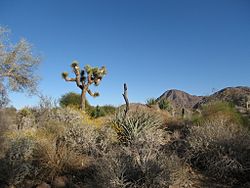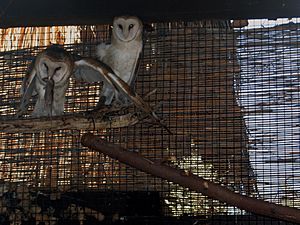Living Desert Zoo and Gardens facts for kids

The gardens
|
|
| Date opened | March 1, 1970 |
|---|---|
| Location | Palm Desert, California, United States |
| Land area | 1,800 acres (730 ha) (1,720 acres (700 ha) left in natural state) |
| Coordinates | 33°41′45″N 116°22′13″W / 33.69583°N 116.37028°W |
| No. of animals | 430 |
| No. of species | 150 |
| Annual visitors | 350,000 |
| Memberships | AZA, WAZA |
Living Desert Zoo and Gardens, formerly the Living Desert Museum, is a desert botanical garden and a zoo located in Palm Desert, Riverside County, California, United States. They are in the Sonoran Desert of the Coachella Valley and Santa Rosa Mountains foothills near Palm Springs, California.
The Living Desert Zoo and Gardens has been a member of the Association of Zoos and Aquariums (AZA) since 1983, and is a member of the World Association of Zoos and Aquariums (WAZA). It has participated in species reintroduction programs including the peninsular bighorn sheep to the local mountains and returning Arabian oryx to Oman.
History and exhibits
The gardens of the Low Desert – Colorado Desert were established in 1970 as a 360-acre (150 ha) wilderness preserve by several trustees of the Palm Springs Desert Museum. By 1974, the gardens housed a kit fox, tortoises, lizards, and two bighorn sheep. In 1974–75 the Mojave Garden was built, a replica of the High Desert – Mojave Desert. Additional facilities have gradually been constructed, including greenhouses, model trains, and designed landscape gardens. New animal introductions include rhim gazelles (1981); mountain lions, bobcats and badgers (1993); meerkats; cheetahs and warthogs (1995); striped hyenas (1998); giraffes and ostriches (2002). The 'Amphibians on the Edge' exhibit shows a variety of different species of frogs, toads, and salamanders (2007). The Endangered Species Carousel was constructed in fall 2009, and the Peninsular Pronghorn Exhibit was constructed in fall 2010. The Living Desert also features an attraction called Camel Rides which allows visitors to ride camels. The exhibit, Monarch of the Desert, was constructed on the North America Trail. Lion Ridge, the habitat for lions, is still incomplete. The Living Desert is one of six accredited (AZA) private zoos in the United States and operates as a non-profit.
Goals
The Living Desert Zoo and Gardens is a zoo and botanic garden combination dedicated solely to the deserts of the world. The programs provide environmental education, native wildlife rehabilitation, plant propagation, and habitat restoration, and captive breeding of African and Sonoran Desert species, including the area's iconic desert bighorn sheep.
Gardens and plant habitats
- The North American desert gardens include re-creations of a variety of desert plant community ecosystems:
- Mojave Desert – Joshua tree (Yucca brevifolia) habitat and Eastern Mojave Cima volcanic field habitat.
- Chihuahuan Desert – Rio Grande-Big Bend (New Mexico-Texas) and northern Mexican Plateau (Mexico) habitats.
- Sonoran Desert – Sonora, Mexico Madrean foothills habitat, Yuma Desert-southwest Arizona habitat and Vizcaíno Desert-Baja California Desert habitat gardens.
- Colorado Desert (Sonoran Desert sub-region) – desert mountains habitat of the indigenous 2,000 to 3,000 feet (610 to 910 m) elevation landscape, the Cahuilla Ethnobotanic Garden of the locally indigenous Cahuilla people, and focus areas representing the Lower Colorado River Valley habitat and the Colorado-Sonoran Desert natural springs, ponds, and riparian habitats.
- Specialized focus gardens include:
- Agave Garden – More than 100 species of Agaves from throughout the Western Hemisphere.
- Aloe Garden – African aloes.
- East African Garden – large collection of native East African plants and trees, one of the larger collections of African plant species in North America.
- Euphorbia Garden – African Euphorbias.
- Aviary Oasis – Coachella Valley native desert palm oasis, with California fan palms (Washingtonia filifera) surrounding a walk in aviary.
- Barrel Cactus garden – Ferocactus species.
- Hummingbird Garden – plants that attract hummingbirds.
- Johnston Cactus Garden – various specimen cacti on display.
- Madagascar Garden – xeric plants endemic-unique to Madagascar.
- Mallow Garden – small collection of desert mallows.
- McDonald Butterfly and Wildflower Garden – nectar (adults) and 'grazing' (larvae) plants that attract migrating butterflies.
- Mexican Columnar Cactus Garden – tall columnar cacti sculptural specimens.
- Ocotillo Garden – nine of twelve known ocotillo species.
- Opuntia Garden – various prickly pear (Opuntia) and cholla (Cylindropuntia) plants.
- Palm Garden – several hundred palm (Arecaceae) trees, of over fifty species from around the world.
- Primitive Garden – plants from the Jurassic period – cycads and ferns.
- Sage Garden – Salvia species of melliferous flower honey forage sage plants.
- Sheep Food Garden – plants that are food sources for desert bighorn sheep.
- Smoke Tree Garden – local native smoke trees (Psorothamnus spinosus) in a natural desert wash setting.
- Sonoran Arboretum – trees from the greater Sonoran Desert region in a designed garden setting.
- Wortz Demonstration Garden – Southwest landscape design display garden.
- Yucca Garden – Yucca species in a designed 'strap foliage garden.
Other features
The Palo Verde Garden Center started when garden staff started propagating plants from the garden collection for sale to members and now sells those plants to the public. Many of the plants sold here may not be found anywhere else.
The Zoo and Gardens featured one of the world's largest LGB model railroad layouts, with about 3,000 feet (910 m) of the track. The world's longest wooden G-scale model trestle (202 feet 8 inches (61.77 m)) lets trains travel between the upper and lower portions of the wash in which it was built – an almost 2-foot (0.61 m) drop. The trains started as part of the annual WildLights holiday program and ran only in the evenings. In 2001 the trains started running throughout the year and during the day. The trains and track belong to the gardens.
See also
 In Spanish: Jardín botánico y zoológico Living Desert para niños
In Spanish: Jardín botánico y zoológico Living Desert para niños


